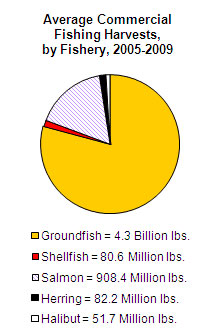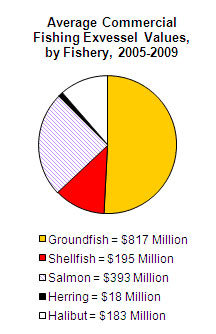|
Fish Factor Gifts From the Sea December 27, 2010
Sponge Bob, for example, is set to be the next rage in fiber optics. Researchers at Bell Labs have found that the sponge euplectella grows glass fiber networks that are far more advanced than any found in today’s telecommunications industry. Wild salmon sperm is the first bio-material ever used for light emitting diodes (LEDs) which light up the numbers in digital clocks and all kinds of electronic equipment. photonics experts can insert light emitting molecules into pure fibers made from salmon sperm DNA to create superior lighting devices. The bio-material could someday reduce the need for heavy metals and other hazardous materials commonly used in lighting. For hundreds of years Asian cultures have used jellyfish to treat arthritis, high blood pressure and back pain. Some jellyfish have a special bio-luminescence that has proven useful in medical research. Chitin, a substance found in the shells of crab, shrimp and other crustaceans, is packed with medical miracles. Chitin is made of carbohydrates that bond with red blood cells to form artificial clots, and seal massive bleeding wounds in just 30 seconds. Shrimp-based bandages are now being used by our troops in Afghanistan. Ground up shrimp shells are also being tested in a nasal spray by British researchers as a treatment for allergies and hay fever. A new product called enzycol has been created by Russian researchers using enzymes in king crab shells that help heal severe burns. The researchers also claim that sea urchin pigment is remarkable for its anti-oxidant, anti-bacterial and anti-inflammatory properties. From sea cucumbers comes the basis of a new immunity enhancing drug; another made from brown seaweed reduces damage from radiation exposure. The venom of the cone snail is being used in the U.S. to treat severe chronic pain that doesn’t respond to other treatments. Just a few micrograms is said to be one thousand times more potent than morphine. Close to 15 drugs derived from marine organisms are in various stages of testing for cancer treatments. The lowly sea squirt appears to be especially promising. Fish oil is helping to clear the air in New Zealand. Researchers have found that adding fish oils to animal feed reduces the release of methane gas by 25 to 40 percent in sheep. Methane is a potent greenhouse gas that traps nearly 20 times as much heat as carbon dioxide. Over 20 percent of global methane emissions come from farm animals. Gifts that keep on giving Alaskans will again reap the economic benefits from huge seafood harvests next year. Notably, the Bering Sea/Aleutian Islands (BSAI) pollock fishery is back on track to handle a catch of 1.25 million metric tons (nearly three billion pounds). That is a 54% increase of over the past two years, but in line with the average catch of pollock sustained by the Bering Sea fishery for the past 30 years. In the Gulf of Alaska the pollock catch also was boosted by 13.5% to 96,215 tons (13.7 million pounds). Together the BSAI and Gulf of Alaska pollock fisheries comprise the largest fishery in the U.S. and one of the biggest in the world. Similarly, Alaska provides much of the world’s codfish and 2011 catches got the nod for nice increases by fishery managers. In the Bering Sea, the harvest of half a billion pounds (228,000mt) of Pacific cod is a 35% increase. The Gulf quota of 65,100 mt (143 million pounds) is an increase of 9%. Sitka Sound will be home to an even bigger herring fishery next year. State managers peg the annual spring harvest at 19,490 tons, compared to 18,293 tons in 2010. Biologists believe the Sitka Sound herring stock is at the highest level since the state began monitoring the stock in 1964. The big fish picture from ADF&G, 2010:
Salmon corrections A few corrections have been made to the Alaska Salmon Price Report which covers the crucial May-August sales season. Number crunchers at The state Dept. of Revenue/Tax Division discovered some inadvertent “mislabeling” and “miss-categorizing” of salmon from one region of the state, according to market watcher Ken Talley. The amended numbers show that the average price for frozen sockeye fillets was a whopping $5.06/lb this summer, not $3.62/lb. as was originally calculated. “This coincides more closely with anecdotal evidence at the time,” Talley said. It also shows that supply is a key ingredient in determining the price, he added. Corrected figures show that sales of frozen sockeye fillets were “more modest” at 7.4 million pounds, instead of the 10.4 million pounds originally reported. Sales of frozen H&G (headed/gutted) chum salmon turned out to be 34.7 million pounds, or three million pounds higher than originally calculated. H&G remains the dominant product form for Alaska chum salmon.
This weekly column focusing on Alaska's seafood industry began in 1991, and it now appears in over 20 newspapers and web sites. A spin off - Fish Radio - airs weekdays on 30 radio stations in Alaska. The goal of both is to make all people aware of the economic and social importance of Alaska's fishing industry to our state, the nation and the world. Happy New Year and thanks for your continued support of fishing news!
|
||||


